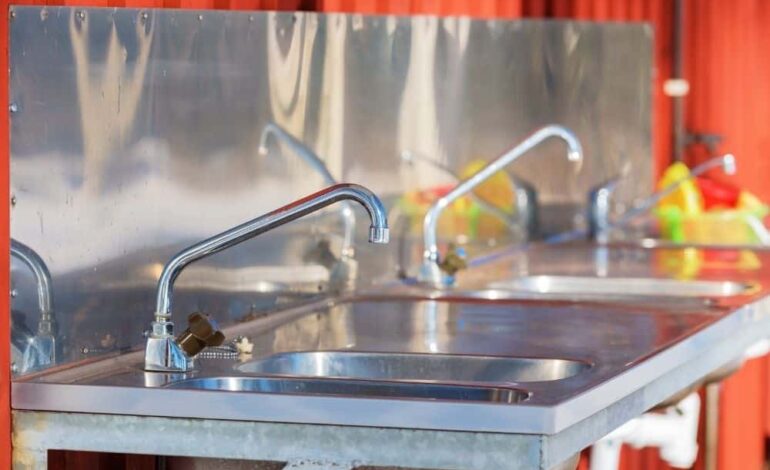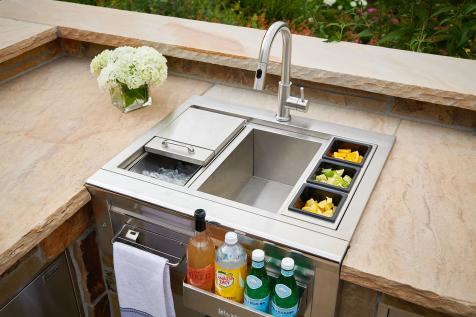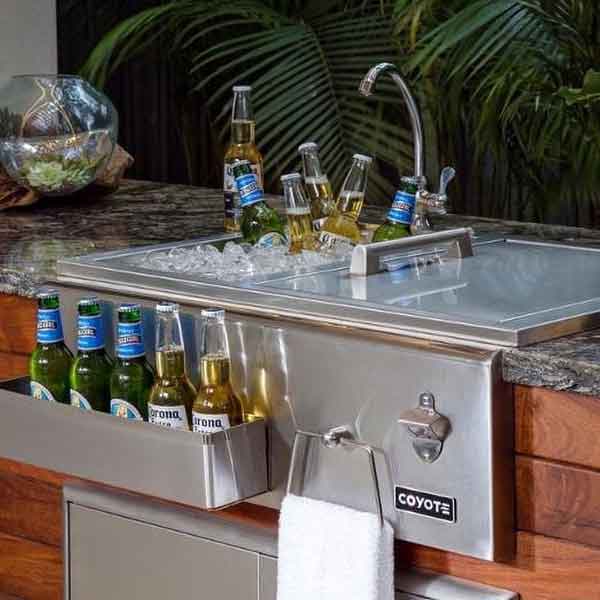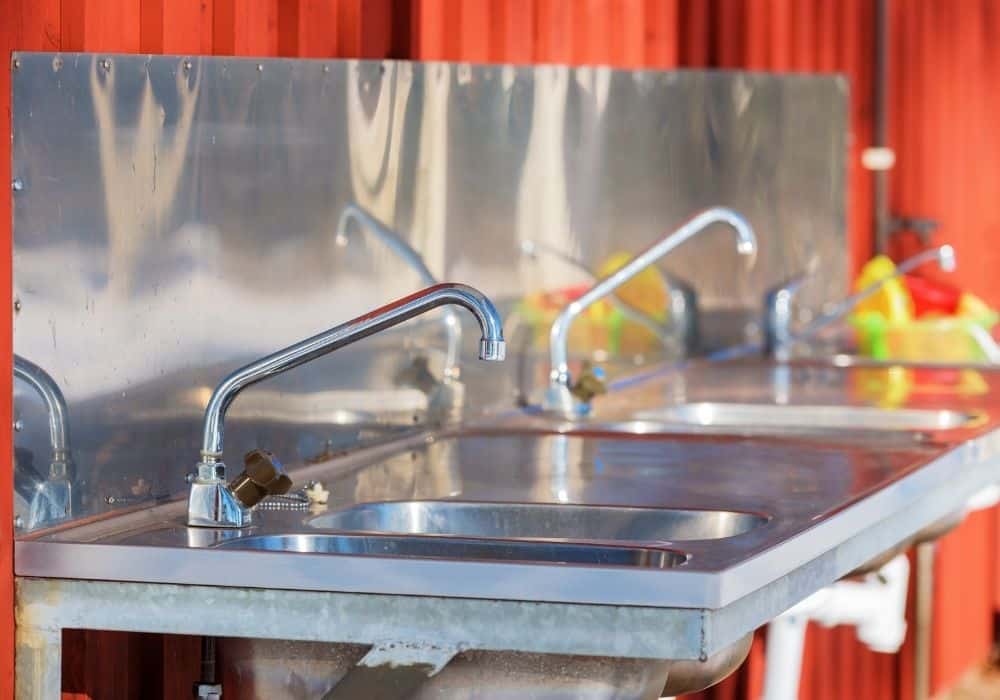
Outdoor Kitchen Sink Must-Have or Luxury?
The rise in popularity of outdoor kitchens is undeniable. Industry professionals affirm the value addition these kitchens bring to a home. In fact, a study by Absolute Outdoor Kitchens reveals a remarkable ROI of 100-200% for homes equipped with an outdoor kitchen compared to those without. But, the lingering question for many remains: “Should my outdoor kitchen have a sink?” If you’ve pondered this, you’re in the right place.

The Charm of an Outdoor Kitchen
An outdoor kitchen serves as an alfresco extension of your indoor space. It’s not just a place to whip up meals, but a delightful zone to entertain guests, savor the fresh air, and relish nature’s ambiance. Essentially, it’s an expansion of your living area, making way for more enjoyment and social interaction.
Ensuring Your Outdoor Kitchen Lasts

Maintaining your outdoor kitchen is paramount. Protection from weather extremities, regular cleaning, and periodic checks are vital for longevity. If you’re considering enhancing your outdoor space, be aware of the following upkeep essentials.
Benefits of an Outdoor Kitchen:
- Enhanced interaction: Cook and converse with guests without having to constantly dash indoors.
- Cost-efficient: While high-end custom designs can be pricey, basic islands provide functionality without the hefty price tag.
- Efficient design: A basic 10-foot long design covers necessities like essential appliances and counter space.
- Flexible sizing: Bigger kitchens, ranging from 12-14 feet, provide additional work space.
- Dining space: Larger outdoor kitchens can also accommodate a dining area, adding to the experience.
Installing an Outdoor Kitchen Sink: A Quick Guide
Building an outdoor kitchen requires planning and consideration. If you’re thinking about incorporating a sink into your outdoor kitchen, here’s a quick guide:
Steps to Install an Outdoor Kitchen Sink:
- Determine Space: Ensure you have adequate space to accommodate the kitchen layout and its components.
- Set a Budget: Decide if you want a permanent or portable kitchen, factoring in your financial capacity.
- Consider the Climate: Ensure materials and designs align with the climatic conditions of your location.
- Choose Your Cooking Style: Decide between traditional or grilled cooking methods.
- Maintenance: Ensure that the materials chosen for your outdoor kitchen are durable and easy to maintain.
Sink in an Outdoor Kitchen:

In an outdoor kitchen, a sink enhances functionality, offering a handy spot for the chef to wash hands and a solution for guests to clean up without venturing indoors – essential after enjoying saucy dishes like ribs. Beyond hygiene, a sink is invaluable for drink preparation, cleaning dishes, and rinsing fruits, especially if the space includes a bar. While most kitchen sinks, including stainless steel, marble, soapstone, and granite, are suitable for outdoor use, it’s crucial to choose one that can withstand the elements.
Outdoor Kitchen Sink Drain Options:
When designing an outdoor kitchen, a pivotal question that arises is how to drain the sink. With its necessity for plumbing, the sink’s drainage is contingent on the environmental conditions and budget considerations. Here are the primary ways to manage drainage based on the kitchen’s size and usage:
- Use of Under-sink Bucket:
- Simplest and most cost-effective method.
- Easily hidden inside a cabinet.
- Ideal for smaller kitchens with minimal food consumption.
- The primary drawback is its limited capacity, requiring frequent emptying.
- Dry Well: An underground structure that disposes of unwanted water.
- Self-contained Lift Station: A unit that pumps the water to a higher elevation for disposal.
- Connection to Drainage with a Pipe: A more permanent solution, directly linking the sink to the existing drainage system.
Among these, the under-sink bucket is straightforward and affordable, but its capacity can be limiting, making it most suitable for smaller outdoor kitchens.
Opting for Regular Plumbing in Outdoor Kitchens
Choosing regular plumbing for an outdoor kitchen involves utilizing drainage pipes similar to an indoor setup. While this method demands the most preparation, effort, and financial outlay, it offers unparalleled convenience. Some of its features and considerations include:
- Seamless Integration: Functions just like an indoor kitchen sink.
- Garbage Disposal Capability: The only drainage method that supports garbage disposal systems.
- Challenges: Setting up plumbing outdoors can be intricate and labor-intensive, especially if the outdoor kitchen is situated a distance away from the primary residence. In such cases, a gravity system or small pump station might be required.
- Professional Assistance: Due to the complexity, this is a task best left to expert plumbers, reflecting in its higher cost.
- Temperature Versatility: A significant perk is that a plumber can channel both cold and hot water from the main house.
Despite its higher price tag, the convenience it offers is unmatched. However, before setting up, it’s wise to explore the potential causes of kitchen sink leaks to avoid future issues.
FAQs:
Do I need a sink in my outdoor kitchen?
A sink in the outdoor kitchen is more than a necessity as in the other case; everything will be taken into the house and taken out of the house after washing. Similarly, if one can keep plates, glasses, and serving pieces in its outdoor kitchen, they might be well washed outside.
How do I get water to my outdoor kitchen?
Outdoor kitchen areas are a great addition to a backyard, allowing us to host our guests comfortably. The outdoor kitchen with a good drainage system installed also contains water to avoid running in and out of the house to prepare meals and grill different items. A sink closer to the home is better to draw water easily with less expense.
How do you drain an outdoor sink?
Draining an outdoor sink is not such an annoying process in proper drainage pipes are fitted to a drain as one can pay a strict eye on it that what should be thrown into the sink. In dry drainage or bucket system, one can remove the bucket after a time interval or use water with ultra-purity as it may not harm its environment.
Is our outdoor kitchen worth the money?
A portable outdoor kitchen gets less money than a permanent concrete kitchen gets. One can remain calm in an open environment and lose his anxiety; how will it not get worth it? Moreover, using an outdoor kitchen with strict rules and procedures and great care will increase its shelf life. A portable kitchen is more profitable, and it may install everywhere and is easy to build in very less time.
Conclusion:
Outdoor kitchens offer a trendy and cost-effective way to enjoy the outdoors, making hosting parties and gatherings seamless. Integrating a sink not only elevates its aesthetics but also proves indispensable for various tasks. It especially aids chefs, allowing them to efficiently cater to guests and ensuring smooth operations.









